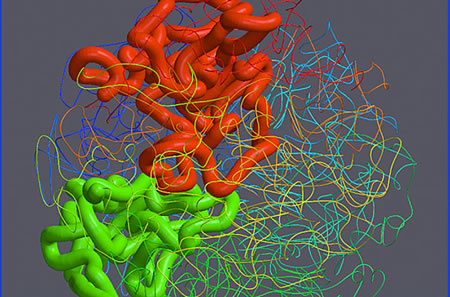3D structure of human genome deciphered - Harvard-MIT
 |
| © Harvard A contiguous stretch of DNA chain inside a fractal globule packs into a compact, unknotted structure, making it easy to pack and unpack. |
"Scientists have deciphered the three-dimensional structure of the human genome, paving the way for new insights into genomic function and expanding our understanding of how cellular DNA folds at scales that dwarf the double helix." - says Harvard Website .
The article reports that a new technology called Hi-C was applied to answer the puzzling question of how each of our cells stows some 3 billion base pairs of DNA while maintaining access to functionally crucial segments.
Scientists have long known that DNA is arranged in a double helix. But if the double helix did not fold further, each cell's genome would be two meters long — far too large to fit into the nucleus of a human cell, which is about a hundredth of a millimeter in diameter.
"It's a whole new view of the chromosome and its place in the cell, and it's a view we've never had before," says Tullius, who studies the structure of DNA. The new structural data reveal that the human genome is organized into two separate compartments, keeping active genes accessible while sequestering unused DNA in a denser storage compartment. Each chromosome alternates between regions of active, gene-rich DNA and inactive, gene-poor stretches.
Just as the 1953 discovery of the DNA double helix by James Watson and Francis Crick revealed how genetic information is stored and copied, the discovery of DNA's 3-D structure offers new insights into how cells control which sections of DNA are translated into proteins.
In the past, many scientists had thought that DNA was compressed into a different architecture called an "equilibrium globule," a configuration that is problematic because it can become densely knotted and does not easily open up.
In brief about Human Genome Project
Begun formally in 1990, the U.S. Human Genome Project was a 13-year effort coordinated by the U.S. Department of Energy and the National Institutes of Health. The project originally was planned to last 15 years, but rapid technological advances accelerated the completion date to 2003. Project goals were to
- identify all the approximately 20,000-25,000 genes in human DNA,
- determine the sequences of the 3 billion chemical base pairs that make up human DNA,
- store this information in databases,
- improve tools for data analysis,
- transfer related technologies to the private sector, and
- address the ethical, legal, and social issues (ELSI) that may arise from the project.
To Know more -
